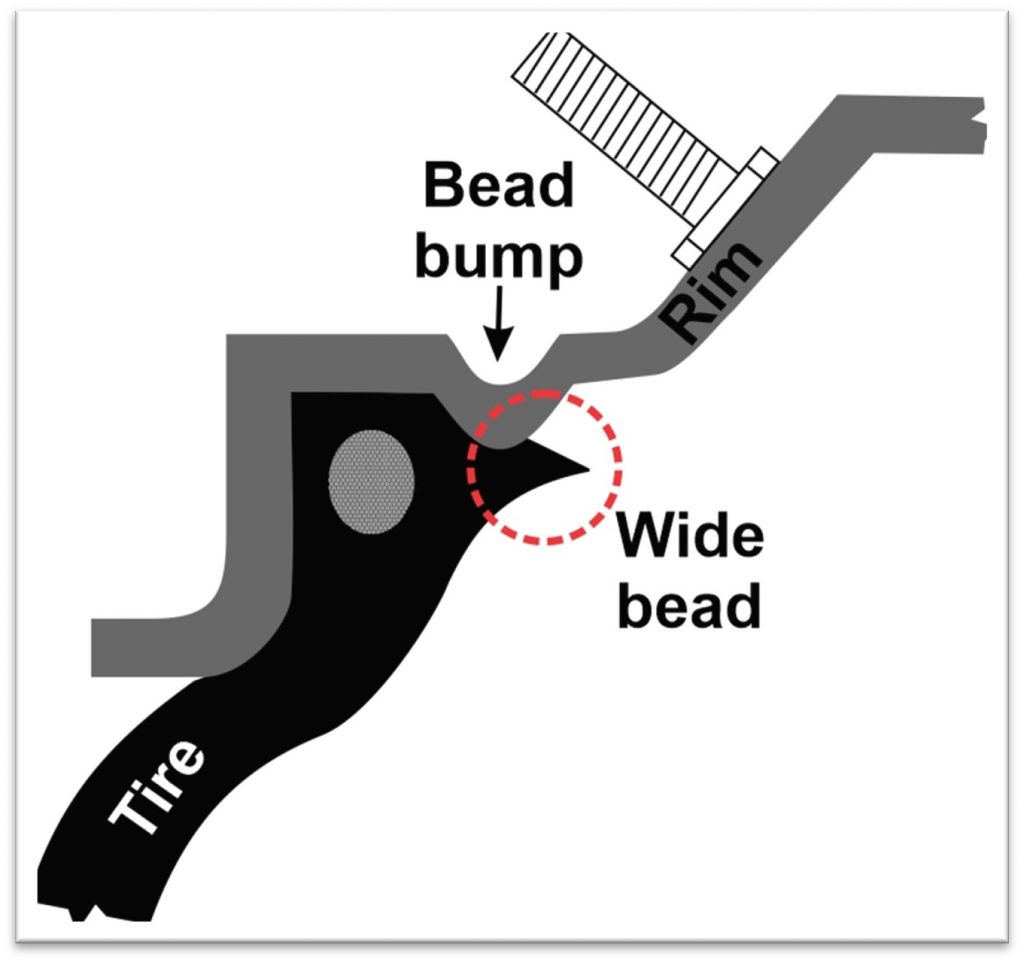WIDE TIRE BEADS BLOW INNER TUBES
BLIN-01 Rev04
Problem: Multiple Coyote beadlock (BL) inner tubes have failed.
Background: The inside edges of all tire beads are very, very sharp. Also, large off road tire beads have wider-than-normal beads. This varies by brand and is not exactly predictable by size. I’ve seen beads as wide as 1.25”. Normal bead width is one-half inch and the sharp edge fits completely behind the bead bump
Fig. 1

Inner tube failures occur in four ways:
1) Due to normal aging and use.
2) Due to being cut by the wide, sharp, inside (air chamber side) edge of the tire bead. A slit tube is immediately obvious and unrepairable.
Fig. 2

3) Due to being punctured or pinched when improperly mounting the final, outside (lug nut side) tire bead.
A punctured (red *) or pinch-weakened tube that eventually fails (right of the red *) may be repaired.
Fig. 3

4) Blowouts are obvious. These are almost always accompanied by a hole or gash in the BL case and have a shattered, exploded look. We’ll only address #2 and #3 and leave blowouts and Mother Nature to your past experience.
Fig. 4

CAUSE: The tire bead’s sharp, saw-tooth edge causes tube failure two ways. One way relates to a weak, stretchy BL case. This was the case for the Australian Stauns that we no longer import. This is fully explained in this post. This link also explains why the stronger Coyote case does not stretch.
The second cause has to do with placing the sharp outside tire bead edge directly on the tube when setting the final tire bead. Do not put the outside tire bead on the tube. This may slit, pinch or puncture the tube between the sharp tire bead’s edge and the drop center. Even our heavy-duty, custom-made tubes cannot always survive this. The tire bead must be placed directly on rim drop center metal.
Fig. 5

SOLUTION 1, GRIND THE TIRE BEAD: Smooth, and round off the inside, sharp tire bead edges. Using a small diameter (2”) drum sander (40 grit or rough stone). As shown, round the sharp inside tire bead edge.
The hard-core rock crawlers have a special blade to remove this portion of the bead. They believe that a “trimmed” bead cures inside bead air leaks on conventional beadlock rims. Coyotes cure inside, leaky, air-burping beads on all rims. Look closely left of the operator’s fingers for sharp versus to the right of the drum for smooth tire bead.
Your goal is to slightly round the tire bead edge as shown. Does this make for leaky tires? I’ve never experienced or heard of rounding causing tire bead air leaks.
Fig. 6

Under all circumstances, pay particularly close attention when mounting the final tire bead. If this is neglected, you stand a good chance of killing the inner tube, particularly with unrounded tire beads. Follow what’s next to avoid that.
Fig. 7

SOLUTION 2, PROPERLY MOUNT THE OUTSIDE TIRE BEAD: Do not pinch the inner tube. When mounting the final tire bead, move the inner tube out of the way toward the inside of the drop center leaving space to put the outside tire bead directly on the metal of the rim’s drop center, NOT the tube. Ensure that the final tire bead is on the rim ONLY and NOT on the inner tube.
For conventional beadlock rims, what follows is of no concern. For those, you just push the outside tire bead onto the rim ready to receive the lock ring and you’re done. You do not have to muscle the outside tire bead over the outside of the rim hence there is no chance of pinching the tube.
SOLUTION 3, USE SOLUTION 1 AND 2: Being a belt and suspenders guy, it makes sense to round the tire beads and properly place the outside tire bead on the drop center.
Fig. 8

GOOD
Fig. 9




